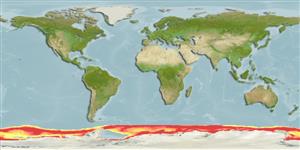Environment: milieu / climate zone / depth range / distribution range
Ecología
marino; rango de profundidad 0 - 550 m (Ref. 11892), usually 0 - 30 m (Ref. 5179). Polar; 60°S - 78°S, 180°W - 180°E
Southern Ocean: Ross, Davis and Weddell Sea, Vincennes Bay, Budd Coast, Antarctic Peninsula, South Orkney and South Shetland islands.
Tamaño / Peso / Age
Maturity: Lm ? range ? - ? cm
Max length : 28.0 cm TL macho / no sexado; (Ref. 5179)
Espinas dorsales (total) : 4 - 7; Radios blandos dorsales (total) : 34 - 38; Radios blandos anales: 30 - 35. Yellowish with dark spots, irregular crossbars. Dorsal and caudal with series of spots sometimes (Ref. 11892).
A cryopelagic species associated with the underside of ice. An anti-freezing substance enable Individuals to tolerate sub-zero temperature (Ref. 33215). Adults feed on copepods and krill (Ref. 5179). Sexually mature individuals spawn once a year (Ref. 89319). Larval pelagic phase is long (Ref. 89319).
Dewitt, H.H., P.C. Heemstra and O. Gon, 1990. Nototheniidae. p. 279-331. In O. Gon and P.C. Heemstra (eds.) Fishes of the Southern Ocean. J.L.B. Smith Institute of Ichthyology, Grahamstown, South Africa. (Ref. 5179)
IUCN Red List Status (Ref. 130435: Version 2024-2)
Threat to humans
Harmless
Human uses
Pesquerías: sin interés
Herramientas
Special reports
Download XML
Fuentes de Internet
Estimates based on models
Preferred temperature (Ref.
123201): -1.8 - -1, mean -1.7 °C (based on 1248 cells).
Phylogenetic diversity index (Ref.
82804): PD
50 = 0.7500 [Uniqueness, from 0.5 = low to 2.0 = high].
Bayesian length-weight: a=0.00617 (0.00322 - 0.01181), b=3.21 (3.04 - 3.38), in cm total length, based on LWR estimates for this (Sub)family-body shape (Ref.
93245).
Nivel trófico (Ref.
69278): 3.2 ±0.34 se; based on food items.
Generation time: 7.8 ( na - na) years. Estimated as median ln(3)/K based on 1
growth studies.
Resiliencia (Ref.
120179): Medio, población duplicada en un tiempo mínimo de 1.4-4.4 años (Fec = 1,500-3,000).
Fishing Vulnerability (Ref.
59153): Moderate to high vulnerability (52 of 100).
Nutrients (Ref.
124155): Calcium = 30.6 [15.7, 69.2] mg/100g; Iron = 0.576 [0.269, 1.185] mg/100g; Protein = 17.1 [15.6, 18.7] %; Omega3 = 0.406 [0.217, 0.752] g/100g; Selenium = 11.5 [4.2, 25.6] μg/100g; VitaminA = 28.7 [6.0, 141.0] μg/100g; Zinc = 0.58 [0.38, 0.90] mg/100g (wet weight); based on
nutrient studies.
